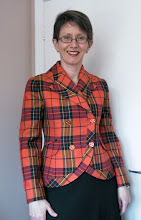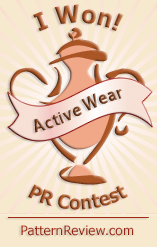 |
| Extreme close up - woven pattern matching at CF placket |
The alterations I made were, in the end, just three:
- Took in side seams, about 2cm on each side at underarm and more at the hem.
- Shortened it by 5cm.
- Raised centre back neck slightly.
I originally thought the underarm was way too low, but taking it in took care of that problem.
I took a few photos of the construction of the back yoke/arm opening bands. Ignore the Vogue instructions and do it my way instead!
I've left the last few cm unattached at the front shoulder edge. This will allow you later to sew the shoulder seams of the shirt body and bands separately for a better shoulder finish.
Vogue says to complete all topstitching at this point but don't! Topstitch the back to side seam only.
At right, I've sewn the shirt shoulder seams (French seams) and attached the back triangular yoke, WS to WS. It helps if you've left the CB seam unsewn in the seam allowance area.
In the photo at left, I have also sewn the shoulder seams of the bands (regular seam, trimmed and pressed open) and I've attached the back V shaped band to the back yoke.
With this construction order, you can sew the bands continuously from in front of the shoulder, over the shoulder and down to the point of the V. You do have to do this in two passes.
The trickiest part is the V point itself. Precision sewing and lots of trimming are essential.
In the shot to right you can see the preparation for final toptitching. This construction method allows you to start at the right underarm and topstitch continuously through the V and to the left underarm.
You'll see this shirt again on this blog ... soonish.








I love the style/seam lines of this pattern - it's going to look fabulous in white.
ReplyDeleteThank you for the detailed explanation of sewing order to achieve the beautiful binding effect of this shirt. This is on my to do list and I'll be sure to consult this post when I get to it.
ReplyDeleteOnce again, I love it when you tell us how to do it much better.
ReplyDelete